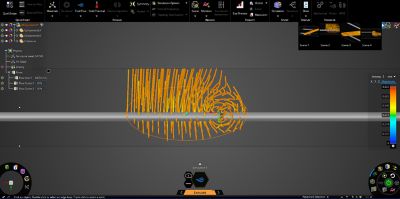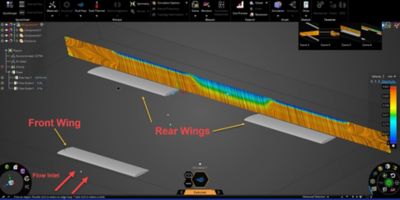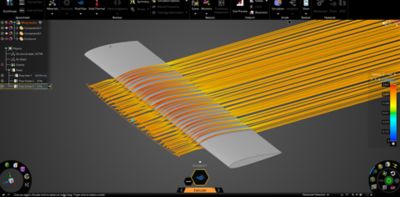Case Study
-
United States -
United Kingdom -
India -
France -
Deutschland -
Italia -
日本 -
대한민국 -
中国 -
台灣
-
-
產品系列
查看所有產品Ansys致力於為當今的學生打下成功的基礎,通過向學生提供免費的模擬工程軟體。
-
“Ansys' simulation software played a critical role in justifying my data results. This level of visualization and validation would not have been feasible with physical tests alone, and my justifications would have remained speculative. Therefore, my collaboration with Ansys was fundamental to the successful completion of my final paper. This experience ultimately led me to the decision to pursue a career in computational engineering, with a particular interest in contributing to industrial research and development in this field.”
— Aryaman Bansal, Student, The Shri Ram School, Moulsari
The International Baccalaureate Diploma Program (IBDP) is an internationally recognized educational program offered to students in 11th and 12th grades. As part of this program, all students are expected to write a mini research paper, known as the extended essay, which is graded during the board exams. One student’s physics extended essay explored the aerodynamic effects of aircraft flying in formation.
Using 3D models of airplane wings, Aryaman Bansal, a student at the Shri Ram School, Moulsari, conducted CFD simulations in Ansys Discovery. Bansal’s research indicated that formation flight could enhance fuel efficiency, supported by higher lift-to-drag ratios in formation versus individual wings. Moreover, Bansal’s paper achieved the highest attainable grade in the IBDP examination.
Challenges
Bansal began by reading about migratory birds utilizing formations to conserve energy in a research paper. He explored whether similar principles could enhance airplane fuel efficiency. He discovered existing hypotheses on this topic; however, no concrete theories had been established. Therefore, he conducted research to examine the drag and lift forces on differently positioned 3D-modeled airplane wings. The initial objective was to model a standard wing and verify the generation of a wingtip vortex. Through the simulation, the length of the vortex could be approximated, which had a significant influence on the design of the 3D models. Bansal, who had prior experience with Ansys computational fluid dynamics (CFD) and finite element analysis (FEA) solutions, turned to Ansys Discovery CFD simulations to conduct this research. This knowledge was a driving factor behind the decision to undertake this research paper, as attempting the same research with a makeshift physical wind tunnel would not yield reliable results.
Engineering Solution
Using Discovery, Bansal:
- Used the program’s boundary condition definitions to set up an external fluid flow wind tunnel.
- Utilized the force calculation feature in the CFD simulations to measure the drag and lift acting on the wings in formation.
- Visualized the wingtip vortex with the program’s streamline feature, which was central to the aerodynamic benefit of flying in formation.
- Used the iteration-force charts to measure the uncertainty in the calculated values.
Benefits
Employing engineering simulation was pivotal in achieving Bansal’s learning objectives. Without Ansys, a makeshift wind tunnel would have needed to be utilized, which would have yielded highly uncertain results and limited the ability to analyze the trend of the lift-to-drag ratio. Equally important was Discovery’s speed, which enabled Bansal to complete each mesh-based simulation in less than 30 minutes. Furthermore, it exhibited very low uncertainty in the drag and lift force values, which fell within the order of magnitude of 10-4.
The complex wingtip aerodynamics demanded a robust approach that makeshift physical wind tunnels could not fulfill, given the unreliability of the quantitative data obtained from them. Through Discovery CFD simulations, Bansal not only addressed this challenge but also grasped the vital role of simulations in industrial and scientific research.
Results
Bansal’s research paper was a part of his IBDP submission in the May 2023 series. He graduated from the IBDP with a score of 44/45 from The Shri Ram School Moulsari and aspires to study engineering at the university level in the future. Additionally, he hopes to participate in various computational engineering competitions at the university level.
Subsequently, Bansal aims to work in the industrial computational engineering research and development sector. Through the use of Ansys, he gained insight into how complex real-world problems were being solved at an unprecedented pace by leveraging computational techniques that blend human ingenuity with computing power.

Streamlines Results Visualization: The streamlines feature of Ansys Discovery was employed to confirm the existence of the spiraling wingtip vortex and to gain a clearer comprehension of the upwash generated by the wingtip.

Vector Planes Results Visualization: The results visualization options in Ansys Discovery were utilized to analyze the airflow around the wings, specifically focusing on the wingtips (as evident from the spiraling vectors at each end of the wing)

Streamlines Results Visualization: The streamline feature was also utilized to verify the appropriateness of the flow conditions for the simulations and to ensure that no flow separation was occurring. Flow separation could have interfered with the primary focus of the research.
查看 Ansys 的服務與產品
查看 Ansys 的服務與產品
立即聯絡我們
感謝您聯絡我們!
我們將在此解答您的問題,並期待與您交流互動。Ansys 的銷售團隊成員會立即與您聯絡。











